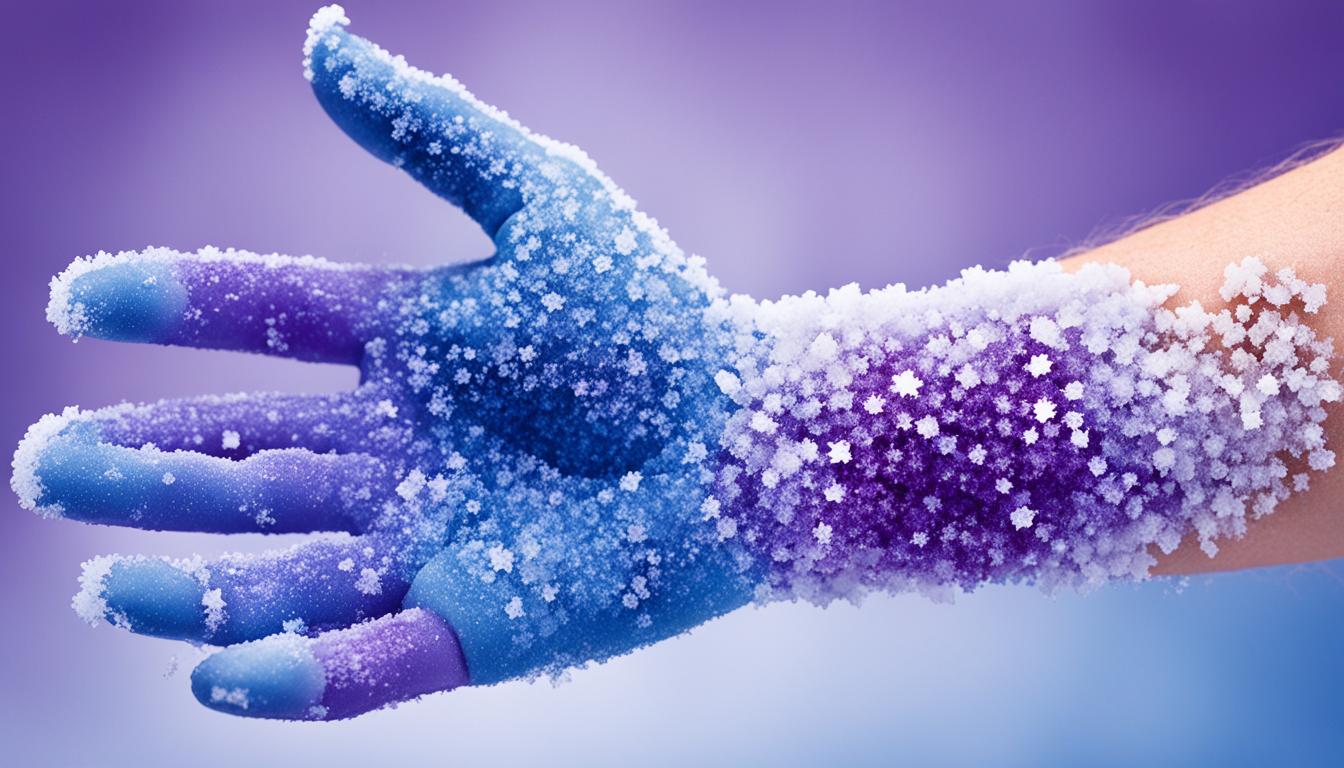Frostbite happens when skin and the tissues underneath freeze from being in extreme cold. It’s a serious illness that brings pain, numbness, blisters, and skin color changes. To stop further harm and help the skin heal, knowing the signs, causes, and cures for frostbite is key.
Symptoms of frostbite are aching, feeling no sensation, getting blisters, and the skin changing colors. Staying in freezing temperatures, especially with the wind, wearing wet clothes, and having poor blood flow leads to frostbite. Age, health issues, and taking certain drugs can make getting frostbite more likely.
Preventing frostbite is crucial. Keep warm, dress right, and don’t stay out in the cold too long to lower your chances. If you do get frostbite, getting treatment fast is vital to stop it from getting worse. Doctors diagnose it from the symptoms and by checking you over. In bad cases, using stem cell therapy might help heal your skin.
Key Takeaways:
- Frostbite is a condition that occurs when the skin and tissues freeze due to extreme cold exposure.
- Main symptoms include pain, numbness, blisters, and changes in skin color.
- Prolonged exposure to cold temperatures, wind chill, wet clothing, and poor circulation are common causes of frostbite.
- Risk factors for frostbite include age, medical conditions, and certain medications.
- Prevention involves staying warm, wearing appropriate clothing, and avoiding prolonged exposure to cold.
- Quick treatment is essential to prevent further damage.
- Stem cell therapy may be used in severe frostbite cases to aid in healing and tissue regeneration.
Frostbite Symptoms and Complications
Frostbite shows different signs depending on its severity. For first-degree frostbite, you might feel pain, itching, and numbness. Second-degree frostbite can give you purple blisters and make the area numb. Third and fourth-degree frostbite can be very bad. It might damage tissues so much that your skin dies. You could lose part of a finger or toe.
Frostbite Symptoms
- Pain, itching, and numbness
- Purple-colored blisters
- Loss of sensation in the affected areas
- Deeper tissue damage
- Tissue loss
- Gangrene
Frostbite’s complications are not to be taken lightly. If it’s severe, tissues might die from lack of blood. This is called gangrene and could make amputation necessary. Blood clots are another risk, which can bring heart problems. Frostbite can also harm you for a long time, leaving you more prone to future bouts.
Frostbite Complications
| Complications | Description |
|---|---|
| Gangrene | The death of tissue due to a lack of blood supply, which may require amputation. |
| Blood clots | Clots that can form in blood vessels, potentially leading to cardiovascular issues. |
| Long-term damage | Permanent effects on the affected areas, including increased vulnerability to future frostbite episodes. |
Don’t wait if you think you have frostbite. Get help right away to avoid serious issues. Quick treatment can prevent a lot of damage.
Frostbite Prevention and Treatment
Avoiding frostbite is key to not getting this bad condition. To stop frostbite, stay out of the cold, keep drinking water, and watch for signs. Doing these things lowers your frostbite risk and keeps you safe.
If frostbite happens, getting help right away is very important. The first step is to warm the affected areas slowly, without rubbing or using direct heat. It’s also wise to see a doctor if it gets worse or if there’s any sign of infection. Treatment might need antibiotics, pain meds, or surgery for severe cases.
Stem cell therapy is a promising new way to treat frostbite. It uses stem cells to help heal and regrow tissue. This treatment could mean better outcomes for frostbite in the future as research keeps moving forward.

